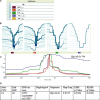Molecular and population analysis of natural selection on the human haptoglobin duplication
- PMID: 22607059
- PMCID: PMC3963445
- DOI: 10.1111/j.1469-1809.2012.00716.x
Molecular and population analysis of natural selection on the human haptoglobin duplication
Abstract
Haptoglobin binds free haemoglobin that prevents oxidative damage produced by haemolysis. There is a copy number variant (CNV) in the haptoglobin gene (HP) consisting of two alleles, Hp1 (no duplication), and Hp2 (1.7kb duplication involving two exons). The spread of the Hp2 allele is believed to have taken place under selective pressures conferred by malaria resistance. However, molecular evidence is lacking and Hp did not emerge in genomewide SNPs surveys for evidence of selection. In Europe, there is geographical constancy of Hp2 frequency, indicative of absence of clinal pressures and that modern day European alleles represent a "snapshot" of their out-of-Africa migrations. In this work we test for signatures of natural selection acting on the Hp CNV in a sample from the UK population (Avon Longitudinal Study of Parents and Children, ALSPAC). We present here heterozygosity decay, pairwise F(ST) values observed between ALSPAC and 301 populations from all five populated continents, extended haplotype homozygosity analyses involving the CNV and 80 SNPs surrounding the CNV ~500kb in each direction, and linkage disequilibrium and pairwise haplotypic analyses involving 160 SNPs on chromosome 16q22.1. Taken together, our results represent the first molecular analysis of natural selection in the Hp CNV genetic region.
© 2012 The Authors Annals of Human Genetics © 2012 Blackwell Publishing Ltd/University College London.
Figures



References
-
- Aucan C, Walley AJ, Greenwood BM, Hill AVS. Haptoglobin genotypes are not associated with resistance to severe malaria in The Gambia. Trans R Soc Trop Med Hyg. 2002;96:327–328. - PubMed
-
- Barrett JC, Fry B, Maller J, Daly MJ. Haploview: Analysis and visualization of LD and haplotype maps. Bioinformatics. 2005;21:263–265. - PubMed
Publication types
MeSH terms
Substances
Grants and funding
LinkOut - more resources
Full Text Sources
Research Materials
Miscellaneous

